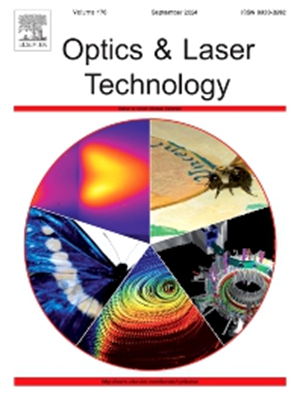基于非线性脉冲神经P系统的红外小目标检测超融合网络模型
IF 4.6
2区 物理与天体物理
Q1 OPTICS
引用次数: 0
摘要
由于目标弱小、背景复杂多变、成像环境恶劣等特点,红外小目标检测技术面临着严峻的挑战。目前,大多数模型都是基于U-net框架或其改进版本,但往往忽略了对输出特征的深度优化。针对这种情况,本文创新性地提出了一种专门为此任务设计的网络,称为UFNet-NSNP。该网络的核心是其独特的超融合网络(unet),该网络有效地集成了多尺度和多层次的特征,显著增强了图像的细节表现力。此外,UFNet- nsnp引入了一种新颖的卷积注意融合模块(CAFM-SNP),该模块通过级联的扩展卷积和注意机制对UFNet的输出特征进行处理和进一步融合,全面增强图像的全局信息捕获能力。同时,该网络在非线性尖峰机制的基础上设计了非线性注意机制(NA),并将该机制与空间注意机制(SA)相结合,形成了新的注意模块(NSNP-A)。该模块可以增强图像的非线性特征。实验在NUAA-SIRST和IRSTD-1k数据集上进行。实验结果表明,uufnet - nsnp在NUAA-SIRST数据集上的IoU为77.46%,在IRSTD-1k数据集上的IoU为69.21%,与现有的最先进(SOTA)方法相比,它具有优越的综合性能。代码可在https://github.com/ZYX-111222/UFNet-NSNP上获得。本文章由计算机程序翻译,如有差异,请以英文原文为准。
A ultra fusion network model based on nonlinear spiking neural P systems for infrared small target detection
Infrared small target detection (IRSTD) has become a significant challenge due to the weak target, complex and variable backgrounds, and harsh imaging environments. Currently, most models are based on the U-net framework or its improved versions, but they often overlook the in-depth optimization of the output features. In response to this situation, this paper innovatively proposes a network specifically designed for this task, called UFNet-NSNP. The core of this network is its unique Ultra Fusion Net (UFNet), which efficiently integrates multiscale and multilevel features to significantly enhance the detail expressiveness of images. In addition, UFNet-NSNP introduces a novel Convolutional Attention Fusion Module (CAFM-SNP), which processes and further fuses the output features of the UFNet through cascaded Dilated convolutions and attention mechanisms to comprehensively enhance the global information capture capability of images. At the same time, the network has designed a nonlinear attention mechanism (NA) based on the nonlinear spiking mechanism, and by combining this mechanism with the spatial attention mechanism (SA), it has created a new attention module(NSNP-A). This module can enhance the nonlinear features of images. Experiments were conducted on the NUAA-SIRST and IRSTD-1k datasets. The experimental results show that UFNet-NSNP achieved an of 77.46% on the NUAA-SIRST dataset and 69.21% on the IRSTD-1k dataset, it demonstrates superior comprehensive performance compared to existing state-of-the-art (SOTA) methods. The code will be available at https://github.com/ZYX-111222/UFNet-NSNP.
求助全文
通过发布文献求助,成功后即可免费获取论文全文。
去求助
来源期刊
CiteScore
8.50
自引率
10.00%
发文量
1060
审稿时长
3.4 months
期刊介绍:
Optics & Laser Technology aims to provide a vehicle for the publication of a broad range of high quality research and review papers in those fields of scientific and engineering research appertaining to the development and application of the technology of optics and lasers. Papers describing original work in these areas are submitted to rigorous refereeing prior to acceptance for publication.
The scope of Optics & Laser Technology encompasses, but is not restricted to, the following areas:
•development in all types of lasers
•developments in optoelectronic devices and photonics
•developments in new photonics and optical concepts
•developments in conventional optics, optical instruments and components
•techniques of optical metrology, including interferometry and optical fibre sensors
•LIDAR and other non-contact optical measurement techniques, including optical methods in heat and fluid flow
•applications of lasers to materials processing, optical NDT display (including holography) and optical communication
•research and development in the field of laser safety including studies of hazards resulting from the applications of lasers (laser safety, hazards of laser fume)
•developments in optical computing and optical information processing
•developments in new optical materials
•developments in new optical characterization methods and techniques
•developments in quantum optics
•developments in light assisted micro and nanofabrication methods and techniques
•developments in nanophotonics and biophotonics
•developments in imaging processing and systems

 求助内容:
求助内容: 应助结果提醒方式:
应助结果提醒方式:


